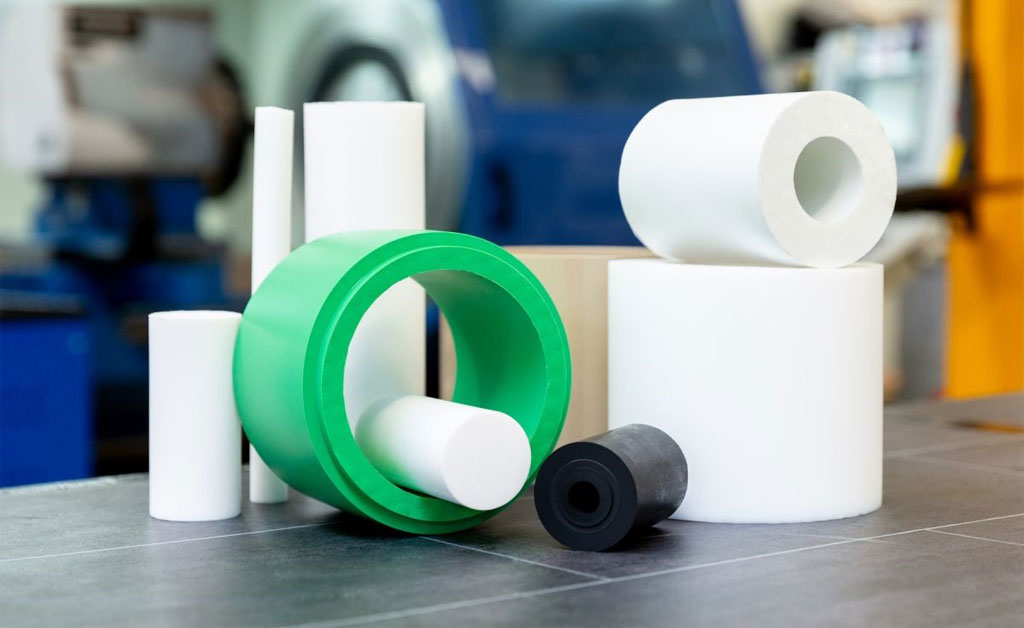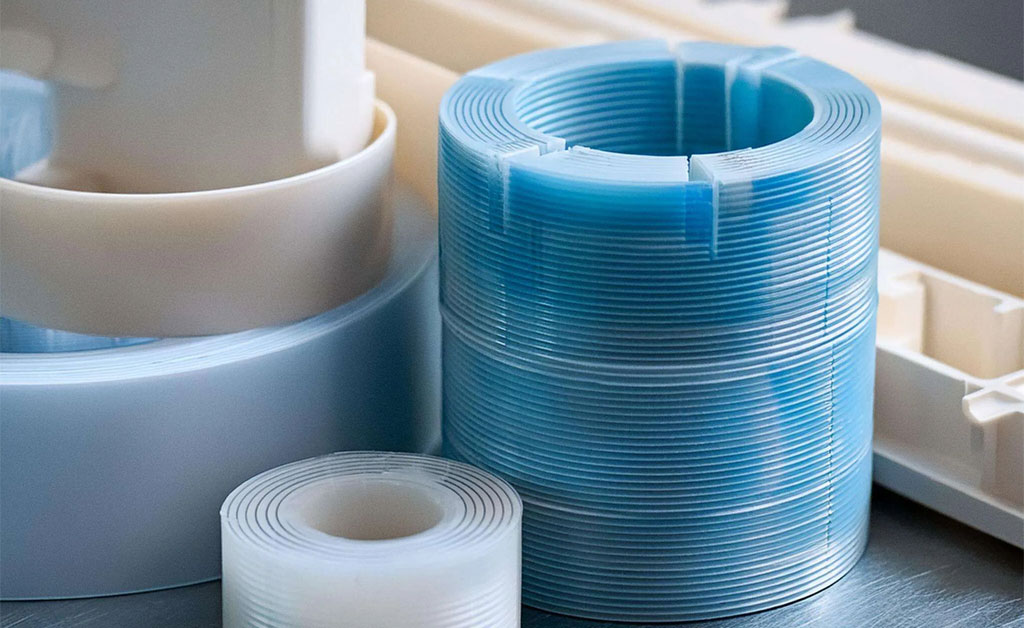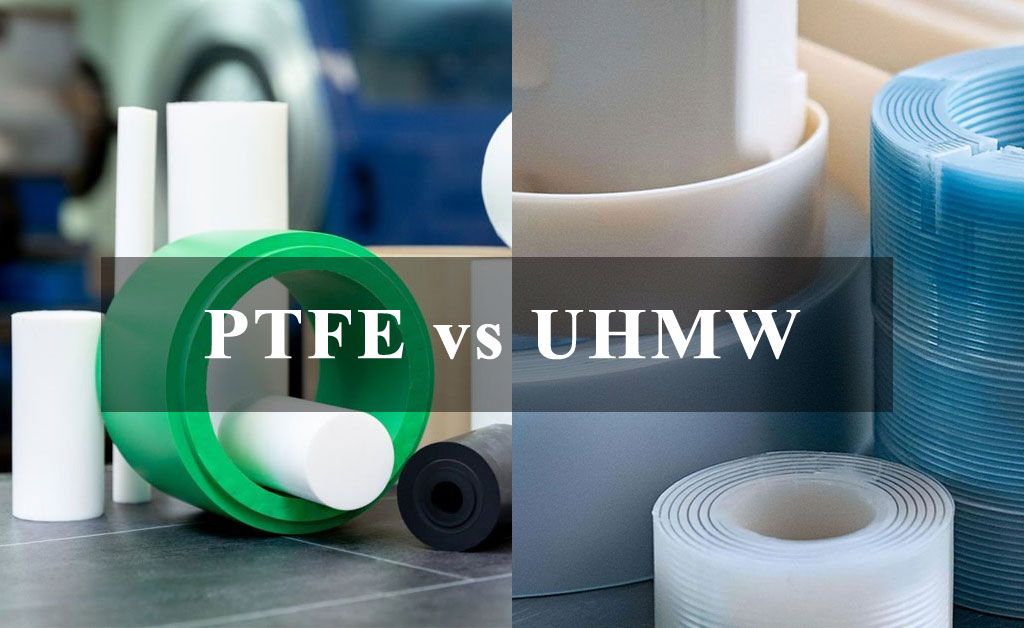When selecting materials for engineering or industrial applications, especially where durability, low friction, and chemical resistance are critical, two plastics often stand out: PTFE (Polytetrafluoroethylene) and UHMW (Ultra-High Molecular Weight Polyethylene).
Both offer exceptional properties, but their differences make them suitable for different tasks.
This article explores PTFE vs UHMW in detail—highlighting their composition, characteristics, advantages, limitations, and applications.
What is PTFE?

PTFE (Polytetrafluoroethylene) is a synthetic fluoropolymer of tetrafluoroethylene. Commonly recognized by the brand name Teflon, PTFE is known for its exceptional chemical resistance and extremely low coefficient of friction.
Key Properties:
- Melting Point: ~327°C (620°F)
- Coefficient of Friction: ~0.05–0.10 (very low)
- Density: ~2.2 g/cm³
- Temperature Range: -200°C to +260°C
- Chemical Resistance: Excellent, even against harsh acids and bases
- Water Absorption: Nearly zero
- Color: Typically white or off-white
Advantages of PTFE
- Superior Chemical Resistance: PTFE is nearly inert and compatible with most chemicals, acids, and solvents.
- Low Friction: Its non-stick surface makes it ideal for sliding applications.
- High Temperature Tolerance: It retains its properties over a wide temperature range.
- Excellent Electrical Insulation: Ideal for electrical and electronic components.
- Non-adhesive Surface: Makes it self-cleaning and ideal for use in food processing or non-stick coatings.
Disadvantages of PTFE
- Soft and Deformable: Susceptible to creep under load (cold flow).
- Expensive: More costly than UHMW and many other plastics.
- Difficult to Bond: Due to its non-stick nature, it requires special surface treatments for adhesives to work.
- Poor Wear Resistance: Not ideal for applications with continuous abrasion.
Typical Applications of PTFE
- Gaskets and seals in corrosive environments
- Non-stick coatings for cookware
- Insulation in aerospace and electronics
- Bearings and bushings where lubrication is not possible
- Chemical storage tank linings
What is UHMW?

UHMW (Ultra-High Molecular Weight Polyethylene) is a subset of thermoplastic polyethylene with extremely long chains. It’s known for outstanding abrasion resistance and high impact strength.
Key Properties:
- Melting Point: ~130°C (266°F)
- Coefficient of Friction: ~0.10–0.22 (low)
- Density: ~0.93–0.94 g/cm³
- Temperature Range: -200°C to +80°C (up to 120°C for short durations)
- Chemical Resistance: Excellent to most chemicals (less so than PTFE)
- Water Absorption: Very low
- Color: Often white, black, or green
Advantages of UHMW
- Exceptional Wear and Abrasion Resistance: Ideal for high-impact, high-wear environments.
- Low Moisture Absorption: Maintains dimensional stability in humid conditions.
- High Impact Strength: Outperforms most plastics in toughness.
- Cost-Effective: More affordable than PTFE in most cases.
- FDA Compliance: Food-grade variants are used widely in conveyor and packaging systems.
Disadvantages of UHMW
- Lower Temperature Resistance: Limited to about 80–120°C.
- Lower Chemical Resistance: Cannot withstand strong oxidizing acids like PTFE can.
- Difficult to Glue or Weld: Like PTFE, it has low surface energy.
- Dimensional Tolerance: High thermal expansion can impact precision parts.
PTFE vs UHMW: Head-to-Head Comparison
| Property | PTFE | UHMW |
|---|---|---|
| Temperature Resistance | Up to 260°C | Up to 80–120°C |
| Friction | Lower (~0.05–0.10) | Low (~0.10–0.22) |
| Chemical Resistance | Excellent (near universal) | Very good, but not against strong oxidizers |
| Wear Resistance | Moderate | Excellent |
| Impact Strength | Moderate | Extremely high |
| Density | Higher (~2.2 g/cm³) | Lower (~0.93 g/cm³) |
| Machinability | Good (soft and easy to cut) | Excellent (tough and impact-resistant) |
| Cost | Higher | More economical |
Typical Applications of UHMW
- Conveyor guides and wear strips
- Chute and hopper liners in mining or agriculture
- Marine fender pads
- Food processing machine parts
- Gears, sprockets, and bearings in packaging equipment
Which Material Should You Choose?
Choose PTFE if:
- The application involves high temperatures (above 120°C).
- You need chemical inertness in highly corrosive environments.
- Electrical insulation is required.
- A non-stick surface is essential.
Choose UHMW if:
- The part will experience constant impact and abrasion.
- You need superior wear resistance for sliding or mechanical contact.
- Budget is a concern—UHMW is more cost-effective.
- Operating temperatures remain below 80–120°C.

